 Animals
Animals  Animals
Animals  Weird Stuff
Weird Stuff 10 Weird Things People Used to Do at New Year’s
 Our World
Our World 10 Archaeological Discoveries of 2025 That Refined History
 Weird Stuff
Weird Stuff 10 Fascinating Facts You Might Not Know About Snow
 Miscellaneous
Miscellaneous Top 10 Things Crypto Was Supposed to Change & What Actually Did
 History
History 10 Huge Historical Events That Happened on Christmas Eve
 Music
Music 10 Surprising Origin Stories of Your Favorite Holiday Songs
 History
History 10 Less Than Jolly Events That Occurred on December 25
 Weird Stuff
Weird Stuff 10 Funny Ways That Researchers Overthink Christmas
 Politics
Politics 10 Political Scandals That Sent Crowds Into the Streets
 Animals
Animals 10 Species That Refused to Go Extinct
 Weird Stuff
Weird Stuff 10 Weird Things People Used to Do at New Year’s
 Our World
Our World 10 Archaeological Discoveries of 2025 That Refined History
Who's Behind Listverse?

Jamie Frater
Head Editor
Jamie founded Listverse due to an insatiable desire to share fascinating, obscure, and bizarre facts. He has been a guest speaker on numerous national radio and television stations and is a five time published author.
More About Us Weird Stuff
Weird Stuff 10 Fascinating Facts You Might Not Know About Snow
 Miscellaneous
Miscellaneous Top 10 Things Crypto Was Supposed to Change & What Actually Did
 History
History 10 Huge Historical Events That Happened on Christmas Eve
 Music
Music 10 Surprising Origin Stories of Your Favorite Holiday Songs
 History
History 10 Less Than Jolly Events That Occurred on December 25
 Weird Stuff
Weird Stuff 10 Funny Ways That Researchers Overthink Christmas
 Politics
Politics 10 Political Scandals That Sent Crowds Into the Streets
10 Reasons To Believe We Have Aquatic Ape Ancestors
Why do modern-day humans appear so drastically different from apes when ape species don’t look all that different from one another?
Fifty years ago, the mainstream scientific consensus said that our ancestors went from living in trees to hunting on the savanna. Then fossil evidence challenged what we thought we knew. In the Great Rift Valley where early hominids thrived, paleontologists discovered that the accompanying microfauna, pollen, and vegetation from that period weren’t savanna species at all.
The image of early hunters chasing red meat through a golden savanna sure painted beautiful illustrations for biology textbooks. But the truth is, we became bipedal before the savanna existed. The former depiction also didn’t account for other puzzle pieces, like the development of our big, complex brains.
Although it began as a lunatic fringe theory, the idea that humans evolved alongside the water and generally had a more aquatic existence has gained considerable steam in the scientific community. Even esteemed natural historian Sir David Attenborough has said, “It isn’t yet the hypothesis that most students are taught, but perhaps its time has come.”
Originally known as the “aquatic ape theory,” it has since been dubbed the “waterside model,” presumably because it sounds a little less silly. Nobody is saying that our ancestors were mermaids swimming in the deep blue alongside whales and talking crabs. Rather, as Elaine Morgan, a proponent of the theory, suggests, “The difference between man and apes has something to do with water.”
Here are just a few reasons to think that the aquatic ape theory might not be so crazy after all.
10 Bigger Brain
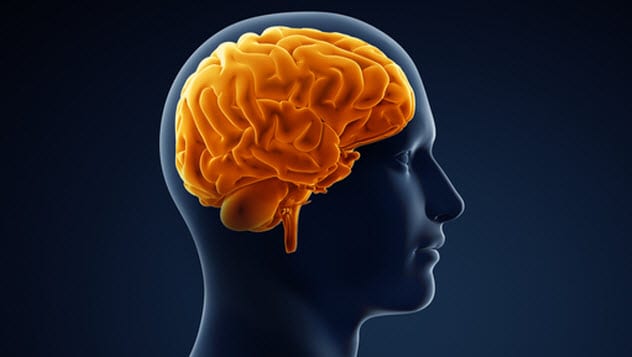
Human brain anatomy is markedly different than that of an ape, especially where the cerebral cortex is concerned. Ours is much larger (even though it doesn’t always seem that way). The qualities that define us—like our abilities to use language, make tools, and have fine motor skills—are the result of this key advantage. The question is: How did our brains evolve for these unique purposes?
The enlargement of the human brain can be compared to those found in seals and dolphins. Marine diets seem to be the only foods capable of fueling brain development as they contain “brain-specific” polyunsaturated fats such as docosahexaenoic acid (DHA), which is an omega-3 fatty acid.
The land-based food of savanna hunters simply doesn’t provide the nutrients needed for this change to occur. No primate can develop a large brain with only a land-based diet. As animals evolve bigger bodies on land, their brains actually shrink. Think of the horse with a walnut-sized brain.
In the sea, however, the opposite is true. For example, dolphins have a brain that weighs 1.8 kilograms (4 lb) because seafood provides the nutrients that stimulate a boost in brain growth. This is why a dolphin has a bigger brain than a zebra despite their similar body sizes. Interestingly, the sperm whale has the largest brain in the world, weighing in at 7–8 kilograms (15–18 lb).[1]
9 Large Sinuses

Our noses are among the most bizarre in the animal kingdom. These oddly shaped snouts are not shared with any other member of the ape family or, for that matter, any other land mammal. We have strikingly large sinuses, which are those empty spaces in the skull between the cheek, nose, and forehead. They seem to serve no significant purpose until one considers the possibility of aquatic adaptation.[2]
If one imagines an aquatic lineage, it seems that our design has a very useful function indeed. These vacant air cavities may be understood as buoyancy aids that could keep our heads above water. They also protect the upper airway tract in a watery world.
Have you ever wondered why our nostrils peculiarly tilt at a downward angle? It does seem to keep water out of the nose when swimming, does it not?
Our sense of smell, however, is notoriously poor. Keep in mind that one doesn’t need a sharp sniffer underwater. For example, diving mammals typically have a reduced sense of smell. It’s only a breadcrumb on the trail, but you may be getting a whiff.
8 Bipedal Shift

Humankind has been walking on two legs for about two million years. (Some sources say four million years, while others say six million. Suffice it to say, it’s been a while.)
Once upon a time, it was believed that the transition from life in the trees to surviving in open grassland was the reason for this change. However, when baboons ventured from the jungle onto the savanna, they stayed resolutely on four legs.
Why? If walking upright for long periods of time is advantageous, why didn’t more species adapt this trait?
Walking on four legs is clearly a superior means of travel when it comes to balance and speed. Of course, now we know that the savanna wasn’t even in existence at that time anyway. Baboons, it turns out, do stand upright from time to time but only for a very specific purpose—to wade through water for food!
David Attenborough explained that during his lengthy career, he saw many species of primate wading bipedally in the water, crossing shallow rivers and pools. But as soon as they hit land, they always dropped onto four legs again. Wading through water is the only circumstance when these primates will walk on two legs.
Humans only walk somewhat efficiently because of our extended legs and vertical hips. But even so, it’s a little awkward. It’s like we are falling forward with style. So how did we learn to do this?
Studies have observed humans walking in water versus on land, and they suggest that it may be how our early ancestors learned to walk. Water has a natural buoyancy that makes walking upright easier. The evolution of our gangly legs and our silly walk was facilitated by a strong need to develop these traits.[3]
7 A Subcutaneous Fat Layer
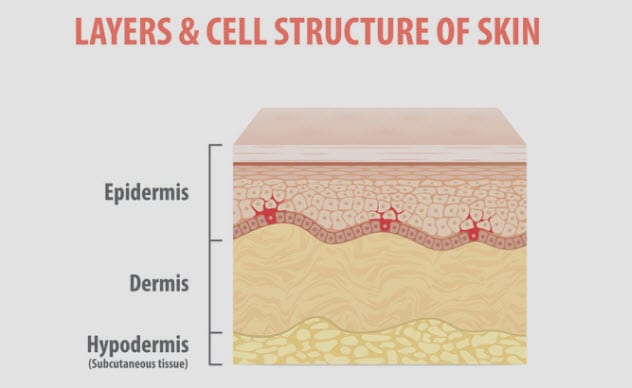
When human babies are born, they look like little cherubs with chubby cheeks and adorable little rolls of fat. This is because their bodies are naturally wrapped in a comparatively thick layer of fat. Other primates are not born so plump. They usually appear to be wrinkly, malnourished balls of skin. So, what gives?
Underneath our skin is a layer of fat that covers almost our entire body. It’s one of the main reasons that humans can become morbidly obese in a way that’s impossible for other primates.[4] No other primates have these subcutaneous fat layers. Lucky us.
However, this fat layer is seen in sea mammals, including whales, seals, walruses, and manatees. This blubber provides buoyancy and insulates the body, maintaining body heat in cold water. Also, the fat streamlines the body and allows for more effective swimming. It creates a serious advantage in aquatic environments because heat loss happens more quickly in water than air. It’s not just cozy, it’s necessary.
6 Curiosities From Birth
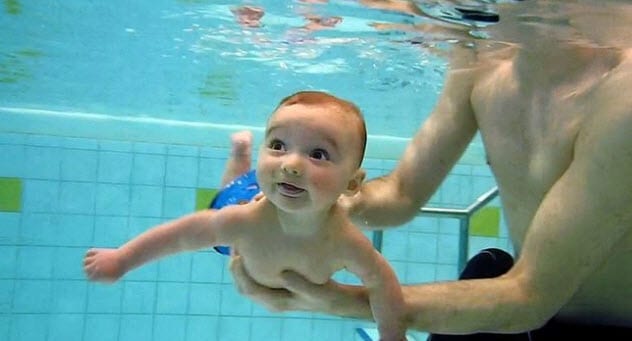
When human babies are submerged in water, they instinctively know to hold their breath and open their eyes. This reflex is called the bradycardic response. Don’t try this at home, but if they are dipped in cold water, their little hearts will instinctively slow as the flow of blood shifts from the peripheral muscles to conserve oxygen.[5]
This reflex safeguards the oxygen for the brain and heart. It’s not rocket science that a freakishly fat baby who instinctively holds his breath underwater didn’t evolve on an African savanna.
When infants first pop out, they are covered in a mucous layer that looks like cheese. This slick coating that keeps out the cold is called vernix caseosa. It used to be believed that it was unique to humans until a research team from Cornell discovered that newborn seals, or pups rather, are also born in this disgusting greasy ball of vernix caseosa.
Now it’s hypothesized that this physiological phenomenon may extend to all marine mammals.
5 Sweat And Tears

Living near salt water requires the occasional release of salt from the body. While sweating is an effective cooldown ability on its own, it’s not really needed when you’re right next to a body of water and can just take a dunk. That’s where tears come in handy.[6]
Crying is useful for shedding excess salt. Humans not only sweat more than any other mammal, but they are also the only mammal that sheds tears. Other mammals cry, but no tears fall. As it turns out, humans exude greater quantities of salt water than any other mammal.
4 Breath Control

The reason gorillas can’t speak has nothing to do with their teeth, tongues, lungs, or vocal cords. We only speak because we have mastered conscious control of the breath, and that’s the key.
All diving mammals hold their breath to shield water from the lungs and regulate the pressures in the respiratory tract as they submerge, feed underwater, and surface. This refined mastery of the airway entrances was preadaptive for the evolution of speech. Living in a seascape could explain why we urgently evolved to be able to control our breath.
In our respiratory valves, we have a unique design from other primates in that a soft palate can lift to close off the nasopharynx. This is a critical feature for aquatic mammals to keep water clear of the respiratory passage.[7]
Humans also have a uniquely descended larynx, which just means that it’s closer to the lungs. As the human baby grows up, the larynx sinks down lower. Again, animals with this design are seals, sea lions, walruses, and dugongs. The one and only primate that has it is us. It allows for gulping large amounts of air easily.
Some researchers argue that our upright posture naturally slid the larynx down, but others suggest that it may have actually been a selected pressure. Next time you hold your breath for a swim, imagine how this seemingly inconsequential feature may have been the biggest game changer in our evolution.
3 Fossils And Observation Of Behavior
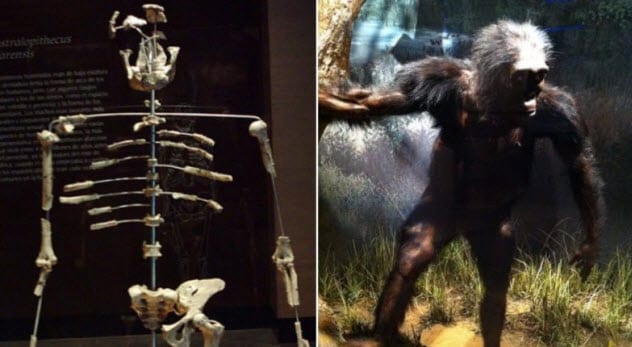
The fossil of Lucy, an early upright-walking hominin, and other well-known ancestors were discovered near shorelines of massive lakes, of which the surrounding area was subject to periodic flooding. In an analysis of 20 hominid fossil sites in East and South Africa, there is fossil evidence that suggests our early ancestors were either living lakeside or in flooded grasslands.
How did they handle this deluge?
Researchers have a clue based on observing baboons at Botswana’s Okavango Delta during the summer months when it is flooded. When fruit becomes rare, the baboons eat water lily roots instead.[8]
Fossil evidence demonstrates that early hominids also resorted to aquatic plants like water lily nuts. The nuts from this thorny plant are a pain in the butt to collect as they require diving 5–7 meters (16–23 ft) deep. Then they can be roasted over a fire where they pop open like popcorn. Even today, people still collect water lily nuts and eat them in the same way.
We also know that our ancestors were chowing down on seafood, in general, about two million years ago. For example, we’ve discovered fossilized bones of a catfish 2 meters (7 ft) long that had been cut with stone tools. It may be no small coincidence that early humans followed the coastlines around the world before heading inland. The water is what they knew best.
2 Pruney Fingers
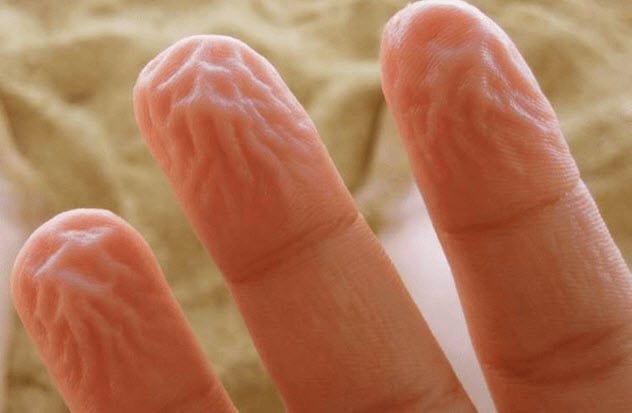
Have you ever wondered why our fingers get all wrinkly when we’re in the water for a while? This active process is controlled by our autonomic nervous system. Evolutionary neurobiologist Mark Changizi believes it served a valuable function in our distant past.
He thinks that the pruney pattern may improve our underwater grip on objects. An independent team from Newcastle University found some support for this hypothesis in a study that demonstrated how people can pick up wet marbles more quickly with pruney fingers than dry ones.
This advantage only applied to the wet marbles. When the marbles were dry, both wet and dry fingers had the same ability. Evolutionary biologist Tom Smulders said, “We have shown that wrinkled fingers give a better grip in wet conditions—it could be working like treads on your car tires, which allow more of the tire to be in contact with the road and [give] you a better grip.”[9]
He explains how this advantage could have helped our ancestors gather food from bodies of water.
1 Nakedness
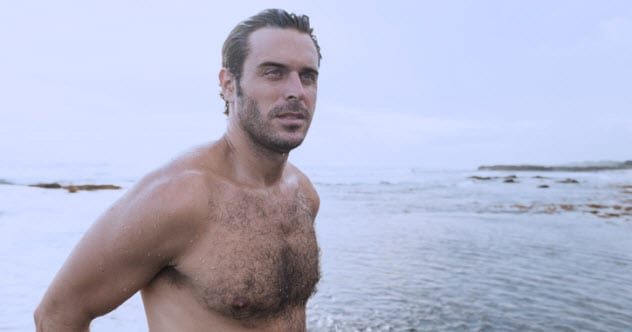
We are the only smooth-skinned primates. Nakedness is an advantage underwater because it allows the body to glide gracefully through the water with ease. Why, then, do we still have hair on our heads?
It is hypothesized that cranial hair remained to protect us from sun radiation. Hair shields the head, but the shoulders and upper arms also tend to have more hair. The hair that did stick around is arranged diagonally, pointing inward toward the midline of the body. This pattern provides the least resistance while swimming.
There’s a close connection between nakedness and water. Mammals that have lost their body hair are the aquatic ones like the hippo, dolphin, manatee. and more. The elephant may be pointed to as an example of a nonaquatic animal that lost its hair, but hold on. Turns out, they have an aquatic ancestor as well. In fact, all naked pachyderms do, even the rhino.
It seems that every naked mammal was conditioned by water at some point.[10] Why not us?
Read more intriguing stories about our human ancestors on 10 Transitional Ancestors of Human Evolution and 10 Distant Human Ancestors and Relatives.








